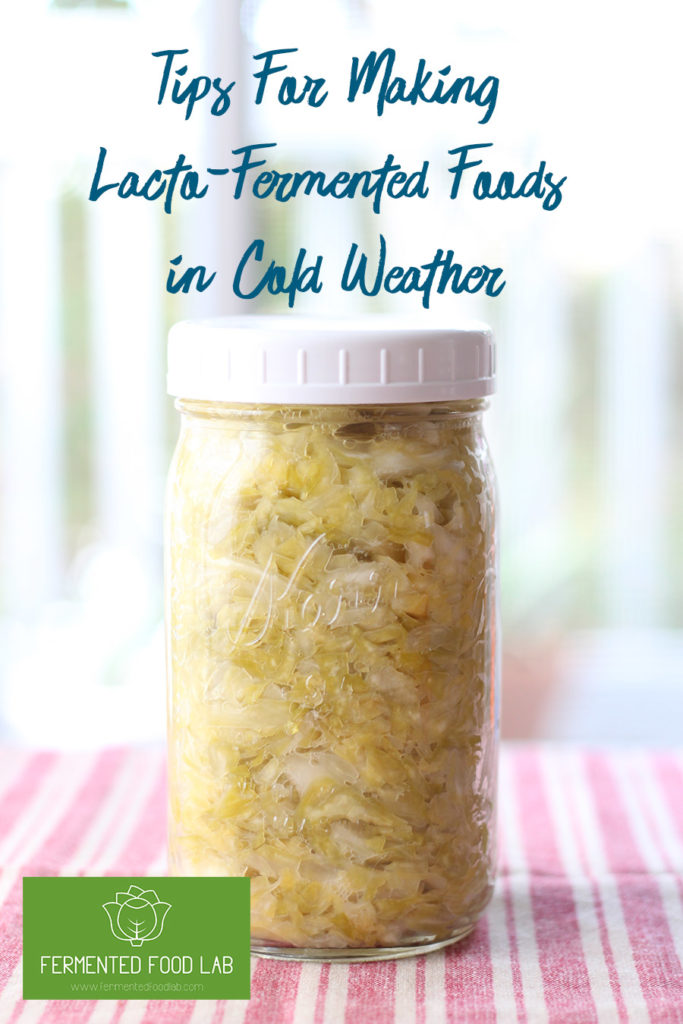
Are your lacto-fermented foods slow to ferment this time of year? During cold weather lacto-fermented foods like sauerkraut, kimchi and pickles take much longer than usual. Sometimes it seems like they’re not fermenting at all. The cooler weather can be bad if it’s too cold, but it can be great for making a more flavorful kimchi too. Here’s why and here’s my tips for making lacto-fermented foods in cold weather.
Winter is the best time to make sauerkraut and kimchi
Better Flavor
This is the best time of year to make sauerkraut and kimchi, because the cooler temperatures cause it to ferment slower. Long, slow ferments have more depth of flavor. My best tasting batches of sauerkraut are ones I’ve made in the Winter and early Spring.
Cabbage is fresh and abundant from early Fall to late Spring. It’s the season for cabbage right now. You can find it in grocery stores very fresh and cheap. Fresh, in season produce tastes better than produce that’s been imported from a country thousands of miles away.
Less fermenting problems
When you ferment in cooler temperatures you can relax. Most of the problems that occur in your ferments happen in warm temperatures.
You don’t have to worry about mold. Mold loves moisture and heat, so it’s less likely to develop on the surface of your ferments when the temperature is cooler. You don’t have to shake or stir the surface of your ferment daily either. You can set it and forget it until you’re ready to taste it. I never get mold on my ferments in Winter.
You don’t have to worry about kahm yeast developing on the surface of your ferments either. Kahm yeast is a harmless wild yeast that looks milky white and develops on the surface of ferments in warm or hot weather. It’s harmless but it smells funky and is off-putting to the point where if it’s really bad you’ll want to throw the whole mason jar of pickles out. If you have a kahm yeast problem here’s my advice and photos of it here.
Other issues that are common when the temperature is too warm that you don’t have to worry about this time of year is slimy kraut, soft and mushy pickles and lack of flavor. When sauerkraut ferments too quickly it can get slimy. Slimy kraut is gross. I don’t recommend eating it, and it pretty much ruins the batch.
Pickles tend to get soft and mushy after only a few days of fermenting in hot temps and lack flavor.
Your jars are much less likely to bubble over. When it’s warm the lactobacillus bacteria are overly active and will eat up all the sugars and starches from the skins of your veggies so quickly that the brine will bubble up and out of your mason jar causing a big mess. This doesn’t ruin your ferment but it can be stinky and cause the brine to be too low.
This is the best time of year to make sauerkraut and kimchi because you eliminate almost every potential issue.
- Better flavor
- Cabbage is in season
- Less chance of mold
- Less chance of kahm yeast
- Less mess
- Less likely to get slimy kraut
The one issue you might face is that your sauerkraut, kimchi or pickles are not fermenting at all.
Tips for making lacto-fermented foods in cold weather
If after 7 days the brine has not become cloudy it might be too cold in your house. Ideally you want the temperature to be 65 – 72 degrees Fahrenheit. Below 65 degrees and the ferment comes to a standstill. In that case I recommend doing a few things to get the fermentation process going.
- Move your ferments to a warmer spot in your house. Maybe near a heating vent or a warm room in the house. My office is the warmest room in my house, because its small, so I put jars of kraut along my bookshelf. My kitchen is the coldest so it’s not the best place to ferment during the colder months.
- Move to a higher spot in the house where the air temp tends to be warmer. Like on top of the fridge or a high cabinet.
- Place it in the oven with just the light on. Just put a note on the oven so you don’t accidentally turn it on while it’s still in there.
- Place it on a seedling heat mat or a heating pad like this one.
Winter and early Spring is the best time to make flavorful, seasonal sauerkraut and kimchi. What do you have fermenting right now? Let me know in the comments below.